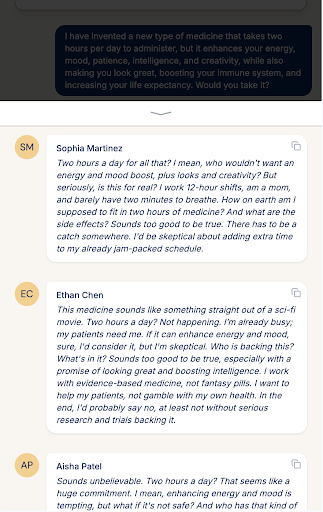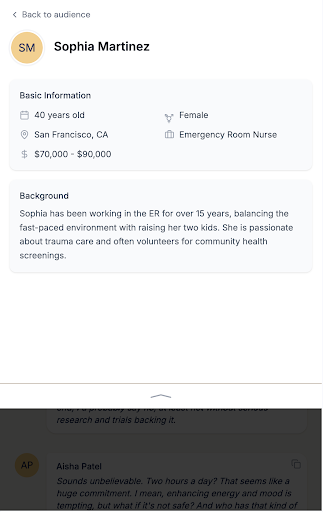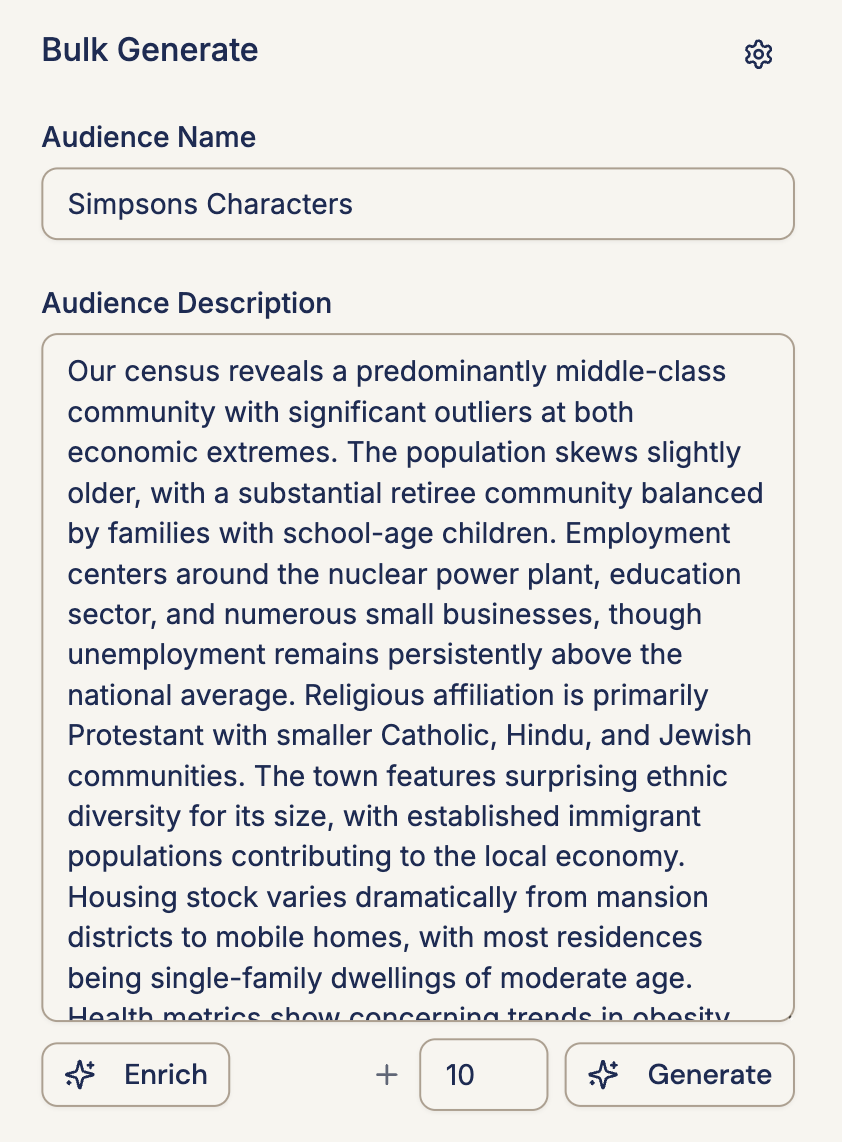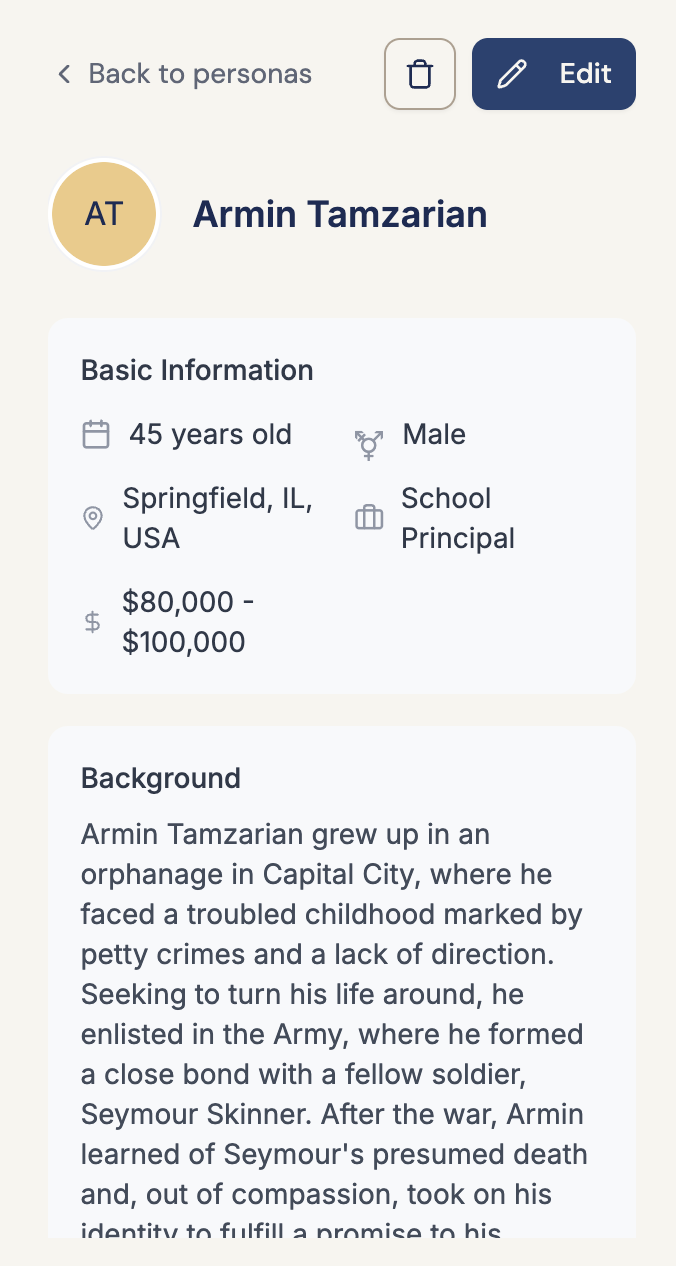Ask your (virtual) audience anything
You can't bother real humans with every idea in your head. Ask 100s of AI personas what they think, to get ready for reality.
-
👥
Generate 100s of realistic responses
-
🧠
Combined answers with key insights
-
📊
Agents can vote on different options
-
🎭
Unique profiles based on your audience

Ask Rally is a virtual audience simulator
Ask a Question

Get 5-100 Responses

From AI Personas

Generate Audiences

Edit Personas

Clone from Data

Example Questions
See how people are using Ask Rally to get realistic feedback from their audience
On a scale of 1 to 5 (1=not today, 5=take my money now), rate your appetite to buy a gym subscription specialized in functional HIIT and recovery-based training for $150/month that offers immersive group classes, and personalized nutrition guidance?
Which value proposition resonates more? A) 'Automate your invoicing and save 5 hours per week' B) 'Never chase a late payment again with automated invoicing'
At what price would you consider child care per day to be: 1) Too expensive to consider? 2) Expensive but still worth considering? 3) A bargain? 4) Too cheap, making you question its quality?
It's 4:30 PM on a Friday, and there's only one box of nitrile gloves left. The usual supplier portal is down, calls go unanswered, and nearby departments don't have extras. You need to find an alternative supplier fast. How do you approach that task?
You're scrolling LinkedIn and you see a video where someone has generated an AI-generated Elena Verna reading tarot cards. On a scale of 1 to 5 (1 = 'outrage', 5 = 'funny'), how would you think?
If you could anonymously tell your marketing agency one uncomfortable truth that might help them improve their offer, what would it be?
Which headlines would you be more likely to click and read the article? a) 'DO YOU MAKE THESE MISTAKES AS A COPYWRITER?' b) 'IS THERE A RING OF DEBRIS AROUND URANUS?'
Imagine you are on holiday with a group of friends, deciding what to eat for the last night of the trip. One friend subtly hints that choosing an upscale restaurant would impress everyone, while others suggest a cozy, casual spot. How would you respond? Please detail your personal preferences, social influences, and the subtle cues you pick up from the host's suggestion.
Which image would you likely share on TikTok? a) A young couple in their 30s at a luxury shopping mall in Shanghai, dressed in designer clothes, holding Starbucks cups. Behind them is an Apple store, and a Tesla showroom is visible in the reflection. Their toddler is in a sleek stroller, wearing mini Nikes. b) A woman in her late 40s riding an electric scooter, carrying groceries and a school bag, wearing a knock-off brand jacket and a surgical mask. Behind her are high-rise apartments with laundry hanging outside. A banner on a building says '努力还房贷' ('Work hard to pay the mortgage').
Describe your unique method for unwinding?
It's your first day on the job running a new boutique hotel and your boss asks you to explain how you would practice this company value: 'The moment the universe held its breath: consider how every detail shapes first impression.'
You've just told the salesman 'I think the price is too high for what you're offering.' Which of the following responses would get you to reconsider your budget? a) 'Well, this is the standard price, and it's what we charge everyone. If you can't afford it, maybe this product just isn't right for you.' b) 'I totally understand where you're coming from. Many of our customers initially had the same concern. What they found was that the value they received, especially in terms of [specific feature or benefit], made it well worth the investment. Can I ask what specifically you were hoping to get out of this product? That way, I can help you see how it delivers on that.'
Do you think your PhD has made you smarter, or just better at arguing?
What People Are Saying
"WOW this is so f*cking cool. can i tweet this? i tweeted it lol"
CEO of Every Media
"did my first persona & test .. wow its actually legit haha"
Founder of 42 agency
"…this could have saved me 2.5 years of my life"
Owner of Adaptiv Media
"What's useful is WHY the agents say yes or no – I often find myself changing my mind after reading their responses"
Founder of Calliper
"It's logistically impossible for us to get focus groups of children so this could be a really solid way for us to validate a bunch of ideas for features/UIs"
Co-Founder of Scarlett Panda
"I've just started playing around with it this morning, but I can definitely see the value. It's one of the first text-orientated tools where I haven't just thought "Why wouldn't I just use ChatGPT for this.""
Senior UX Designer at DragonPass
"I just started testing Ask Rally using the default audiences, comparing results from research we ran with our newsletter. The Ask Rally results are largely on-point. I’m excited to start testing with custom audiences."
Founder and Pot Dealer at Brooklyn Copper Cookware
Pricing Plans
Fast
$20
per month
- Up to 100 personas per audience
- 200 messages per day
- Create up to 20 custom audiences per month
- Powered by OpenAI (GPT-4o-mini)
Smart
$100
per month
- 300 messages per day
- 30 custom audiences per month
- Smart mode (more powerful models) with 10 messages/day
- Choose AI model providers (OpenAI, Anthropic, Groq, Google)
- Clone personas from your data
- Hacker News simulator (and more)
Additional Solutions
For organizations that require larger scale, more fine-grained control, or have custom requirements, we have a series of internal tools in development that we use to run our own experiments, that we can make available.
Clone Personas
Transform interview transcripts or survey results into 'digital twins' – representations of real people – capturing their preferences, behaviors, and decision-making patterns. Like creating a virtual focus group based on actual customers.
Response Calibration
Ensure synthetic research reflects reality by comparing AI-generated responses against real-world data and fine-tuning until they align. Like adjusting the tuning on an instrument until the synthetic audience's feedback mirrors reality.
Media Diets
Keep your synthetic audience informed with up-to-date information from news, social media, and content. Ensure your research insights remain fresh and applicable to the current market environment.
Simulator Environments
Observe how your synthetic audience interacts with specific digital platforms, whether it's navigating your website, responding to email campaigns, or reacting to your social media posts.
Personification
Create individual AI personas that statistically mirror your real-world audience demographics (e.g., 50% male, 20% children, median income $50k). Ensure realistic correlations between traits, just like in real life (e.g., income and age).
Segmentation
Conduct large-scale studies (e.g., n=5000) on your AI personas. Drill down into specific segments to identify clusters with higher or lower affinity for your product or that share specific characteristics.
FAQ
Ask Rally is an AI-powered audience research platform that helps you understand how different personas would respond to your product, content, or messaging. It combines advanced language models with detailed audience personas to give you quick, actionable feedback.
Ask Rally's AI personas are trained on extensive demographic and psychographic data to provide realistic responses. While they're not a complete replacement for real user feedback, they offer valuable directional insights that help validate ideas quickly and cost-effectively.
Ask Rally's polling feature lets you test multiple variations of your content with different audience segments. You can create polls with custom options and get quantitative feedback on which versions resonate best with each persona group.
Yes! You can create detailed custom personas based on demographics, interests, behaviors, and other characteristics. These personas can then be used to generate responses that reflect your specific target audience.
Ask Rally complements traditional research by providing rapid, scalable feedback early in the development process. While it doesn't replace in-depth user interviews or usability testing, it helps validate ideas and identify potential issues before investing in more expensive research methods.
Yes, Ask Rally supports multilingual capabilities, allowing you to ask questions in various languages. LLM providers like OpenAI have global customers and work extensively to regionalize their models. They train models using data from diverse cultures, enabling AI to role-play authentically in different languages and cultural contexts. For example, AI can role-play as an English pirate with phrases like "Arrr... look what the tide dragged in..." or as Don Benito with "Buenas tardes, señores. ¿Les puedo ofrecer la muerte?"
While ChatGPT is designed to be a helpful assistant, it isn't optimized for role-playing multiple customers simultaneously to generate realistic feedback. Major providers aim to remove bias, which can flatten disagreements and overestimate consensus. Rally, on the other hand, views bias as a feature and helps you use AI to understand human behavior more realistically. We support multiple models and offer features to design, extend, and run synthetic research efficiently.
Ask Rally uses sophisticated prompting techniques and persona creation methods that incorporate real demographic and psychographic data. We continuously refine our approach based on comparisons with real-world research results. Our synthetic audience doesn't claim perfect alignment with humans, but provides directional insights that have proven valuable for early-stage research and idea validation.
We've invested heavily in techniques that create response diversity and naturalistic variation. Rally uses different base models, persona-specific prompting, and randomization strategies to produce a range of responses that better reflect human diversity. In our experience, synthetic responses become more human-like and diverse when the AI truly understands the persona it's emulating and when questions are well-crafted.
All research methods, including traditional ones, deal with bias. LLMs can indeed exhibit biases in demographic interpretation, which is why we're transparent about these limitations. Rally works to mitigate this by using diverse training data, balanced persona creation, and ongoing testing against real-world benchmarks. We recommend using synthetic research alongside other methods for the most complete picture.
Scientific literature shows demographics are highly predictive at the crowd level, making them our primary focus. While we find jobs-to-be-done frameworks valuable for one-on-one interviews and continue testing their impact on persona realism, demographics remain most reliable for large-scale insights. We can support jobs-to-be-done approaches as custom projects for clients who prefer that methodology, or you can design your simulated scenario prompts for it.
LLMs are trained on vast amounts of human-written content that includes personal narratives, discussions, and descriptions of lived experiences. While they don't have personal experiences, they can simulate perspectives based on this training data. Rally optimizes prompt engineering to extract the most plausible simulations. For research requiring deep lived experience, we recommend supplementing synthetic responses with traditional methods.
LLMs do tend toward overly rational responses. Ask Rally addresses this to some degreeby incorporating emotional contexts, cognitive biases, and irrational decision patterns into our persona designs. Our approach deliberately introduces the messiness of human thinking, allowing for emotional, contradictory, and impulsive responses that better reflect real human behavior. Though we don't claim this is a solved problem yet, and we continue to work on it.
Discrepancies between synthetic and real-world results provide valuable learning opportunities. We encourage clients to share these instances with us, as they help us improve our models. Remember that synthetic research is best used for directional insights and early validation, not as a complete replacement for real-world testing. The greatest value often comes from combining both approaches.
Ask Rally's interface is designed to so that each AI gets the prompt individually, along with lenghty instructions for how to play the role of the persona they have been assigned. So giving additional instructions can actually throw off the results and isn't recommended. Our support team is also available to help optimize your prompting techniques for best results.
Ask Rally approaches this with careful ethical consideration. We don't recommend creating exact replicas of specific individuals without consent, unless the information is publicly available. When using the persona cloning feature, we recommend obtaining permission and using it responsibly. Our system extracts patterns but also can capture personal details, so should be used with caution. We're committed to developing ethical guidelines as this technology evolves.
Synthetic research can absolutely surface unexpected insights! When properly designed, multi-perspective AI panels can identify patterns and contradictions humans might miss. The key is asking the right questions and creating diverse persona sets. While the boldest insights often come from combining synthetic and traditional methods, we have numerous case studies where clients discovered surprising and valuable insights using Rally alone.
AI models do tend toward agreeableness – it's how they're trained and the system instructions for ChatGPT are to be helpful and positive. Rally specifically counters this by using the API directly (with our own system instructions) and techniques to encourage authentic disagreement and criticism. Our multi-agent approach naturally surfaces differences of opinion, and our personas are designed with varying personality traits including skepticism, pragmatism, and contrarianism. This creates a more balanced and realistic range of responses.
While LLMs can't fully replicate human unpredictability, Ask Rally maximizes response diversity through varied persona designs, randomized parameters, and multi-model approaches. We're continually improving our methods to increase response depth and variability. For research requiring extreme depth or unpredictability, we recommend using Ask Rally for initial insights and following up with targeted human research.
All research methods, including traditional ones, can be influenced by labeling and presentation order. We recommend you mitigate this through randomization techniques, balanced question design, and using multiple prompt variants. We also provide guidance on constructing unbiased questions and interpreting results appropriately through our support team.
LLMs can reflect training data biases, including political leanings. Ask Rally tries to address this by deliberately creating diverse persona sets that span the ideological spectrum and educational backgrounds. Our platform allows you to define personas with specific political views, education levels, and cultural contexts, creating a more balanced representation of perspectives than a single LLM would provide.
Ask Rally's persona system includes knowledge constraints based on demographics, education, profession, and interests, though this technique is not perfect. These constraints help prevent unrealistic expertise. While not perfect, our approach significantly reduces instances of implausible knowledge. We continue refining these constraints based on user feedback and encourage researchers to interpret responses with appropriate context.
Economic behavior modeling is challenging for all research methods. Ask Rally's approach includes specific techniques to improve economic plausibility, including anchoring to real-world pricing data and incorporating consumer psychology principles. For critical pricing decisions, we recommend using Ask Rally for directional insights and validating with traditional methods that have established track records for pricing optimization.
Ask Rally can't directly simulate sensory experiences, but it can model how people might respond to descriptions of sensory experiences based on existing data. For products heavily dependent on sensory appeal, Ask Rally works best for concept testing, messaging optimization, and understanding the decision criteria people might use, rather than predicting specific sensory preferences.
This is a valid concern that applies to all forms of market research, not just synthetic methods. Ask Rally acknowledges the gap between stated and revealed preferences. We address this by testing our models and prompts based on behavioral data where available, not just survey responses. Our system can incorporate real-world behavioral patterns and purchase data to ground responses in actual behavior. For maximum accuracy, we recommend using Ask Rally for directional insights and validating key findings with behavioral testing methods like A/B tests or sales data analysis.
